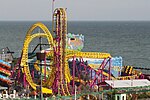Kursaal (amusement park)
1901 establishments in EnglandAmusement parks in EnglandBuildings and structures in Southend-on-SeaDefunct football venues in EnglandDefunct greyhound racing venues in the United Kingdom ... and 8 more
Defunct sports venues in EssexEnglish Football League venuesEvent venues established in 1901Grade II listed buildings in EssexOperating amusement parksSouthend United F.C.Tourist attractions in EssexUse British English from October 2016

The Kursaal () is a Grade II listed building in Southend-on-Sea, Essex, England, which opened in 1901 as part of one of the world's first purpose-built amusement parks. The venue is noted for the main building with distinctive dome, designed by George Campbell Sherrin, which featured on a Royal Mail special stamp in 2011.
Excerpt from the Wikipedia article Kursaal (amusement park) (License: CC BY-SA 3.0, Authors, Images).Kursaal (amusement park)
Southchurch Avenue, Southend-on-Sea Southchurch
Geographical coordinates (GPS) Address Nearby Places Show on map
Geographical coordinates (GPS)
| Latitude | Longitude |
|---|---|
| N 51.5331 ° | E 0.7247 ° |
Address
Tesco Express
Southchurch Avenue
SS1 2ZG Southend-on-Sea, Southchurch
England, United Kingdom
Open on Google Maps










